 Re: CA/OR/WA 04/09–04/25, 2010 - 59 LHs, 2 LShips, 9 Fresnels, 2 Faux LHs, 4 Canadian LHs
#68581
06/20/10 07:40 PM Re: CA/OR/WA 04/09–04/25, 2010 - 59 LHs, 2 LShips, 9 Fresnels, 2 Faux LHs, 4 Canadian LHs
#68581
06/20/10 07:40 PM
|
Joined: Dec 2002
Posts: 1,964
sandy
 OP
OP
Cruise Director
|
OP

Cruise Director
Joined: Dec 2002
Posts: 1,964 |
Friday, April 16: 6 lighthouses, 208 miles: Our first stop was Point Sur Lighthouse. Altho’ docent-led tours are offered on weekends through the year, we were there on Friday and were able to photograph it from Highway 1 using Stan’s newest “toy,” a Nikon D90 with 24X magnification. Not bad considering we were about 12 miles away when this photo was taken: 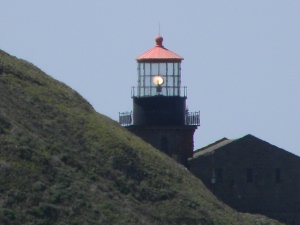 Point Sur Lighthouse–the point is a 381' tall rock that appears to have been broken off from the mainland, leaving a low lying area of land in between. Various parts of the rock’s 10' to 12' wide summit had to be blasted to obtain level areas large enough to accommodate the buildings. The lighthouse is located in a notch on the northwestern extreme of the rock, several feet below the summit to be located below the typical fog level. The picture that follows shows the station’s buildings and the light on the far right of the rock: 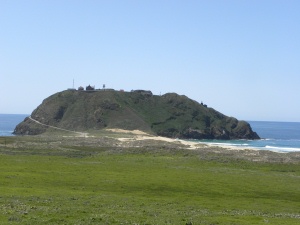 Next stop was Point Pinos Lighthouse, located in Pacific Grove, CA. 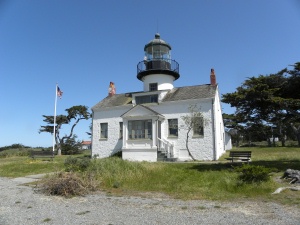 Poiint Pinos Lighthouse–included in the first batch of 8 lighthouses erected on the west coast, this light’s 3rd-Order Fresnel lens, originally intended for Fort Point Lighthouse, first shone in 1855. When the original Alcatraz Lighthouse was extinguished in 1909, Point Pinos became the oldest active lighthouse on the west coast. Next stop was the Mark Abbott Memorial Lighthouse, the brick tower built adjacent to what had been the location of the 1-1/2-story house with a pitched roof surmounted by a square light tower named the Santa Cruz Lighthouse. Built in 1869, that light had a 5th-Order Fresnel lens that was first lit in 1870. That lens was replaced by a more powerful 4th-Order lens in 1913. Sold to a local carpenter in 1948, the structure was dismantled and its lumber used for other projects. 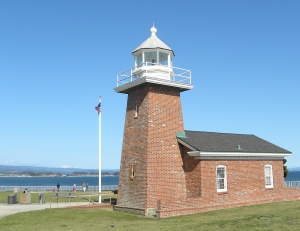 In 1965, an 18-year-old surfer, Mark Abbott, drowned near the point. In 1967, his parents used the insurance money to build a brick lighthouse adjacent to the site of the old light. The original lantern room from the Oakland Harbor Light was used until 1996 when it was replaced due to corrosion. A working optic with a red tint is used in the replacement lantern room today. The lighthouse has been home to the Santa Cruz Surfing Museum, a branch of the Santa Cruz Museum of Natural History, since 1986, but is currently threatened by erosion that is undermining the point. Next was the second lighthouse in Santa Cruz–the Walton Lighthouse, a/k/a Santa Cruz Harbor Light: 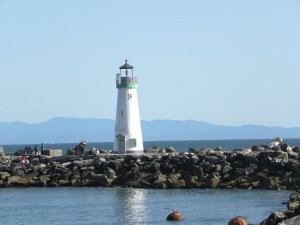 Built in the fall of 2001 on the West Jetty of Santa Cruz Harbor, this tower houses a modern green optic 54' above sea level. Dedicated in 2001, its named for Derek Walton whose brother donated much of the money for the project in memory of Derek, who was a Merchant Marine. Next was Pigeon Point Lighthouse: 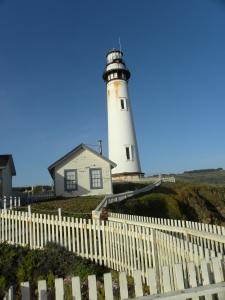 Pigeon Point Lighthouse–the point of land named for the 175' long clipper ship named Carrier Pigeon that had a gilded pigeon as her figurehead that sunk on her maiden voyage in 1853, this area claimed at least 3 more ships before funds were appropriated for a lighthouse in 1871. This 115' tower shares the title of tallest west coast lighthouse with California’s Point Arena Lighthouse, and is similar in design to those at Bodie Island and Currituck Beach in NC, Morris Island in SC, and Yaquina Head in OR. A radio antenna that emitted a Morse code signal unique to Pigeon Point was erected near the tower in 1943. Synchronized with the fog signal, mariners measuring the delay between receiving the radio signal and hearing the fog signal could calculate the distance from the point. Prior to synchronization of the signals, a ship would use radio signals from multiple stations to triangulate its position. The audible fog signal was discontinued in 1976, when modern navigational aides made it unnecessary.
|
|
|
|
Entire Thread
|

 CA/OR/WA 04/09–04/25, 2010 - 59 LHs, 2 LShips, 9 Fresnels, 2 Faux LHs, 4 Canadian LHs
CA/OR/WA 04/09–04/25, 2010 - 59 LHs, 2 LShips, 9 Fresnels, 2 Faux LHs, 4 Canadian LHs
|
sandy
|
06/20/10 11:39 PM
|

 Re: CA/OR/WA 04/09–04/25, 2010 - 59 LHs, 2 LShips, 9 Fresnels, 2 Faux LHs, 4 Canadian LHs
Re: CA/OR/WA 04/09–04/25, 2010 - 59 LHs, 2 LShips, 9 Fresnels, 2 Faux LHs, 4 Canadian LHs
|
sandy
|
06/20/10 11:39 PM
|

 Re: CA/OR/WA 04/09–04/25, 2010 - 59 LHs, 2 LShips, 9 Fresnels, 2 Faux LHs, 4 Canadian LHs
Re: CA/OR/WA 04/09–04/25, 2010 - 59 LHs, 2 LShips, 9 Fresnels, 2 Faux LHs, 4 Canadian LHs
|
sandy
|
06/20/10 11:40 PM
|

 Re: CA/OR/WA 04/09–04/25, 2010 - 59 LHs, 2 LShips, 9 Fresnels, 2 Faux LHs, 4 Canadian LHs
Re: CA/OR/WA 04/09–04/25, 2010 - 59 LHs, 2 LShips, 9 Fresnels, 2 Faux LHs, 4 Canadian LHs
|
sandy
|
06/20/10 11:40 PM
|

 Re: CA/OR/WA 04/09–04/25, 2010 - 59 LHs, 2 LShips, 9 Fresnels, 2 Faux LHs, 4 Canadian LHs
Re: CA/OR/WA 04/09–04/25, 2010 - 59 LHs, 2 LShips, 9 Fresnels, 2 Faux LHs, 4 Canadian LHs
|
sandy
|
06/20/10 11:40 PM
|

 Re: CA/OR/WA 04/09–04/25, 2010 - 59 LHs, 2 LShips, 9 Fresnels, 2 Faux LHs, 4 Canadian LHs
Re: CA/OR/WA 04/09–04/25, 2010 - 59 LHs, 2 LShips, 9 Fresnels, 2 Faux LHs, 4 Canadian LHs
|
sandy
|
06/20/10 11:52 PM
|

 Re: CA/OR/WA 04/09–04/25, 2010 - 59 LHs, 2 LShips, 9 Fresnels, 2 Faux LHs, 4 Canadian LHs
Re: CA/OR/WA 04/09–04/25, 2010 - 59 LHs, 2 LShips, 9 Fresnels, 2 Faux LHs, 4 Canadian LHs
|
sandy
|
06/20/10 11:52 PM
|

 Re: CA/OR/WA 04/09–04/25, 2010 - 59 LHs, 2 LShips, 9 Fresnels, 2 Faux LHs, 4 Canadian LHs
Re: CA/OR/WA 04/09–04/25, 2010 - 59 LHs, 2 LShips, 9 Fresnels, 2 Faux LHs, 4 Canadian LHs
|
sandy
|
06/20/10 11:52 PM
|

 Re: CA/OR/WA 04/09–04/25, 2010 - 59 LHs, 2 LShips, 9 Fresnels, 2 Faux LHs, 4 Canadian LHs
Re: CA/OR/WA 04/09–04/25, 2010 - 59 LHs, 2 LShips, 9 Fresnels, 2 Faux LHs, 4 Canadian LHs
|
sandy
|
06/21/10 12:07 AM
|

 Re: CA/OR/WA 04/09–04/25, 2010 - 59 LHs, 2 LShips, 9 Fresnels, 2 Faux LHs, 4 Canadian LHs
Re: CA/OR/WA 04/09–04/25, 2010 - 59 LHs, 2 LShips, 9 Fresnels, 2 Faux LHs, 4 Canadian LHs
|
WackoPaul
|
06/21/10 02:21 AM
|

 Re: CA/OR/WA 04/09–04/25, 2010 - 59 LHs, 2 LShips, 9 Fresnels, 2 Faux LHs, 4 Canadian LHs
Re: CA/OR/WA 04/09–04/25, 2010 - 59 LHs, 2 LShips, 9 Fresnels, 2 Faux LHs, 4 Canadian LHs
|
Lorie Roe
|
06/21/10 03:50 PM
|

 Re: CA/OR/WA 04/09–04/25, 2010 - 59 LHs, 2 LShips, 9 Fresnels, 2 Faux LHs, 4 Canadian LHs
Re: CA/OR/WA 04/09–04/25, 2010 - 59 LHs, 2 LShips, 9 Fresnels, 2 Faux LHs, 4 Canadian LHs
|
kory63
|
06/21/10 04:18 PM
|

 Re: CA/OR/WA 04/09–04/25, 2010 - 59 LHs, 2 LShips, 9 Fresnels, 2 Faux LHs, 4 Canadian LHs
Re: CA/OR/WA 04/09–04/25, 2010 - 59 LHs, 2 LShips, 9 Fresnels, 2 Faux LHs, 4 Canadian LHs
|
wvlights0
|
06/21/10 07:03 PM
|

 Re: CA/OR/WA 04/09–04/25, 2010 - 59 LHs, 2 LShips, 9 Fresnels, 2 Faux LHs, 4 Canadian LHs
Re: CA/OR/WA 04/09–04/25, 2010 - 59 LHs, 2 LShips, 9 Fresnels, 2 Faux LHs, 4 Canadian LHs
|
sandy
|
06/21/10 10:41 PM
|

 Re: CA/OR/WA 04/09–04/25, 2010 - 59 LHs, 2 LShips, 9 Fresnels, 2 Faux LHs, 4 Canadian LHs
Re: CA/OR/WA 04/09–04/25, 2010 - 59 LHs, 2 LShips, 9 Fresnels, 2 Faux LHs, 4 Canadian LHs
|
MrsTLC
|
06/21/10 10:49 PM
|

 Re: CA/OR/WA 04/09–04/25, 2010 - 59 LHs, 2 LShips, 9 Fresnels, 2 Faux LHs, 4 Canadian LHs
Re: CA/OR/WA 04/09–04/25, 2010 - 59 LHs, 2 LShips, 9 Fresnels, 2 Faux LHs, 4 Canadian LHs
|
Bill and Judy
|
06/22/10 02:15 AM
|

 Re: CA/OR/WA 04/09–04/25, 2010 - 59 LHs, 2 LShips, 9 Fresnels, 2 Faux LHs, 4 Canadian LHs
Re: CA/OR/WA 04/09–04/25, 2010 - 59 LHs, 2 LShips, 9 Fresnels, 2 Faux LHs, 4 Canadian LHs
|
rscroope
|
06/22/10 06:51 PM
|

 Re: CA/OR/WA 04/09–04/25, 2010 - 59 LHs, 2 LShips, 9 Fresnels, 2 Faux LHs, 4 Canadian LHs
Re: CA/OR/WA 04/09–04/25, 2010 - 59 LHs, 2 LShips, 9 Fresnels, 2 Faux LHs, 4 Canadian LHs
|
sandy
|
06/22/10 11:49 PM
|

 Re: CA/OR/WA 04/09–04/25, 2010 - 59 LHs, 2 LShips, 9 Fresnels, 2 Faux LHs, 4 Canadian LHs
Re: CA/OR/WA 04/09–04/25, 2010 - 59 LHs, 2 LShips, 9 Fresnels, 2 Faux LHs, 4 Canadian LHs
|
Lighthouse Loon
|
06/23/10 12:06 AM
|

 Re: CA/OR/WA 04/09–04/25, 2010 - 59 LHs, 2 LShips, 9 Fresnels, 2 Faux LHs, 4 Canadian LHs
Re: CA/OR/WA 04/09–04/25, 2010 - 59 LHs, 2 LShips, 9 Fresnels, 2 Faux LHs, 4 Canadian LHs
|
sandy
|
06/30/10 06:59 AM
|

 Re: CA/OR/WA 04/09–04/25, 2010 - 59 LHs, 2 LShips, 9 Fresnels, 2 Faux LHs, 4 Canadian LHs
Re: CA/OR/WA 04/09–04/25, 2010 - 59 LHs, 2 LShips, 9 Fresnels, 2 Faux LHs, 4 Canadian LHs
|
sandy
|
06/30/10 07:00 AM
|

 Re: CA/OR/WA 04/09–04/25, 2010 - 59 LHs, 2 LShips, 9 Fresnels, 2 Faux LHs, 4 Canadian LHs
Re: CA/OR/WA 04/09–04/25, 2010 - 59 LHs, 2 LShips, 9 Fresnels, 2 Faux LHs, 4 Canadian LHs
|
WackoPaul
|
06/30/10 03:50 PM
|

 Re: CA/OR/WA 04/09–04/25, 2010 - 59 LHs, 2 LShips, 9 Fresnels, 2 Faux LHs, 4 Canadian LHs
Re: CA/OR/WA 04/09–04/25, 2010 - 59 LHs, 2 LShips, 9 Fresnels, 2 Faux LHs, 4 Canadian LHs
|
rscroope
|
06/30/10 07:57 PM
|

 Re: CA/OR/WA 04/09–04/25, 2010 - 59 LHs, 2 LShips, 9 Fresnels, 2 Faux LHs, 4 Canadian LHs
Re: CA/OR/WA 04/09–04/25, 2010 - 59 LHs, 2 LShips, 9 Fresnels, 2 Faux LHs, 4 Canadian LHs
|
wvlights0
|
07/01/10 02:45 AM
|

 Re: CA/OR/WA 04/09–04/25, 2010 - 59 LHs, 2 LShips, 9 Fresnels, 2 Faux LHs, 4 Canadian LHs
Re: CA/OR/WA 04/09–04/25, 2010 - 59 LHs, 2 LShips, 9 Fresnels, 2 Faux LHs, 4 Canadian LHs
|
sandy
|
07/01/10 03:53 AM
|

 Re: CA/OR/WA 04/09–04/25, 2010 - 59 LHs, 2 LShips, 9 Fresnels, 2 Faux LHs, 4 Canadian LHs
Re: CA/OR/WA 04/09–04/25, 2010 - 59 LHs, 2 LShips, 9 Fresnels, 2 Faux LHs, 4 Canadian LHs
|
fra02441
|
07/01/10 02:04 PM
|

 Re: CA/OR/WA 04/09–04/25, 2010 - 59 LHs, 2 LShips, 9 Fresnels, 2 Faux LHs, 4 Canadian LHs
Re: CA/OR/WA 04/09–04/25, 2010 - 59 LHs, 2 LShips, 9 Fresnels, 2 Faux LHs, 4 Canadian LHs
|
sandy
|
07/02/10 07:06 AM
|

 Re: CA/OR/WA 04/09–04/25, 2010 - 59 LHs, 2 LShips, 9 Fresnels, 2 Faux LHs, 4 Canadian LHs
Re: CA/OR/WA 04/09–04/25, 2010 - 59 LHs, 2 LShips, 9 Fresnels, 2 Faux LHs, 4 Canadian LHs
|
sandy
|
07/11/10 05:52 AM
|

 Re: CA/OR/WA 04/09–04/25, 2010 - 59 LHs, 2 LShips, 9 Fresnels, 2 Faux LHs, 4 Canadian LHs
Re: CA/OR/WA 04/09–04/25, 2010 - 59 LHs, 2 LShips, 9 Fresnels, 2 Faux LHs, 4 Canadian LHs
|
sandy
|
07/11/10 05:52 AM
|

 Re: CA/OR/WA 04/09–04/25, 2010 - 59 LHs, 2 LShips, 9 Fresnels, 2 Faux LHs, 4 Canadian LHs
Re: CA/OR/WA 04/09–04/25, 2010 - 59 LHs, 2 LShips, 9 Fresnels, 2 Faux LHs, 4 Canadian LHs
|
sandy
|
07/11/10 05:52 AM
|

 Re: CA/OR/WA 04/09–04/25, 2010 - 59 LHs, 2 LShips, 9 Fresnels, 2 Faux LHs, 4 Canadian LHs
Re: CA/OR/WA 04/09–04/25, 2010 - 59 LHs, 2 LShips, 9 Fresnels, 2 Faux LHs, 4 Canadian LHs
|
WackoPaul
|
07/11/10 04:44 PM
|
|
|
|
Forums39
Topics16,978
Posts184,640
Members2,579
| |
Most Online10,155
Jan 14th, 2020
|
|
|
1 registered members (Rock),
1,087
guests, and 4
spiders. |
|
Key:
Admin,
Global Mod,
Mod
|
|
|

